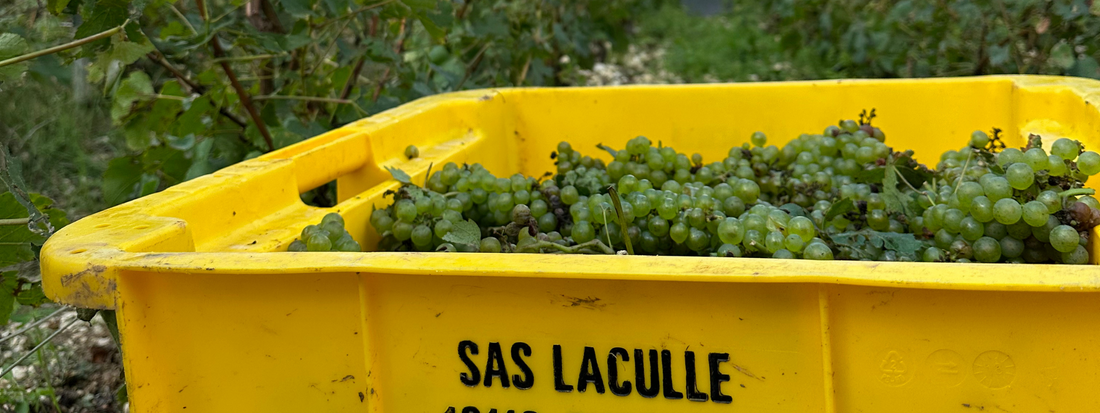
Vendange ’24 – Champagne Harvest Report
After spending a week among the vines for the 2024 Champagne harvest, we’re excited to share a glimpse into what we experienced. From battling the pressures of downy mildew to observing the quality emerging across different sub-regions and grape varieties, it was an eventful and insightful trip. We had the privilege of spending time with our producers, fellow growers, and some chefs de cave from the Grande Marques. While yields were severely impacted by downy mildew and challenging weather—especially the torrential rains of early summer—there’s much to be hopeful about. Despite a cautious start, the grape must we tasted and the conversations we had painted a very promising picture for the potential of this vintage. Only time will tell!
Montagne de Reims
Overall, the Montagne de Reims fared well, with excellent acidity and sugar levels in the grapes. The Pinot Noir we tasted at Sadi Malot was particularly impressive, reaching nearly 11 degrees, and the must was nothing short of superb. In this region, the black grapes were definitely the stars of the show.

Arthur Lelievre, a new addition to our portfolio this year with his first release of wines, saw remarkable success with his Meunier from the village of Taissy. Arthur shared, “Practicing organic viticulture has been more challenging than ever this year. However, despite the reduced yields, the quality of both the Pinot and Meunier looks fantastic. All the extra work in the vineyard has truly paid off.”

Côte des Blancs
Chardonnay typically thrives under challenging weather conditions, often outperforming Pinot Noir in difficult years. But in 2024, the tables may have turned. While the Chardonnay still holds great promise, it doesn’t appear to be reaching the heights of previous years.
We spent some time with Philippe Glavier in the heart of the Côte des Blancs. His must from the village of Oger was pleasantly ripe and exhibited good early acidity, though the quality may not be as exciting as usual in the Côte de Blancs the yields were higher than black grapes due to the later ripening.
Vallée de la Marne
Here, Meunier was the clear standout, particularly from villages like Damery, Cumières, and Fleury-la-Rivière. The grapes arriving at the press were in excellent condition. In the Grande Vallée around Ay and Mareuil-sur-Ay, reports from our growers suggested that Pinot Noir was once again the showstopper.
At Henin-Delouvin in Cerseuil, we were blown away by the vibrancy, punchiness, and fruity energy of the Meunier. Julien Henin commented, “We had to work incredibly hard this year, especially in our organic plots. Cerseuil sits lower in elevation compared to other villages along the river, which presented additional challenges. However, the clay-heavy soils produced a level of concentration in the Meunier that we’ve never seen before—it’s really exciting!”

Côte des Bar
Unfortunately, the Côte des Bar suffered the most in terms of yield. This was compounded by severe spring frosts and the widespread impact of mildew. All grape varieties were affected, with the Chardonnay particularly suffering—many bunches showed signs of damage. We spent time with Laculle in the heart of the Aube and Héléne Beaugrand in Montgueux, and even with the chalky soils of Montgueux the grapes here still suffered badly.

However, unlike 2023’s battle with Botrytis, the mildew doesn’t impact the juice quality as directly. So while the yields were low, what remains should still produce interesting wines. We’re eager to see how the vin clair will turn out this spring!
Grande Marques
We were fortunate to spend some time with Clément Pierlot, Chef de Cave of Champagne Pommery. His overall view of the region was that the quality of grapes arriving was most impressive from the Grande Vallée villages, particularly Ay and its neighboring areas. There was also significant excitement surrounding Pommery's own vineyards, especially the exceptional fruit from Ay used for Cuvée Louise.

While discussing the week’s work with one of our growers, we were joined by Didier Mariotti, Chef de Cave of Veuve Clicquot. Didier mainly commented on how the dry weeks in September had truly saved the vintage. He mentioned that he will be carefully selecting which juices to use, relying heavily on his relationships with grower producers to decide which ones to work with. He was especially impressed by the Pinot Noir and Meunier from the Montagne de Reims.
It will certainly be a challenging year for the big houses in terms of quantity of good juice, let’s see how they report in the coming weeks!
